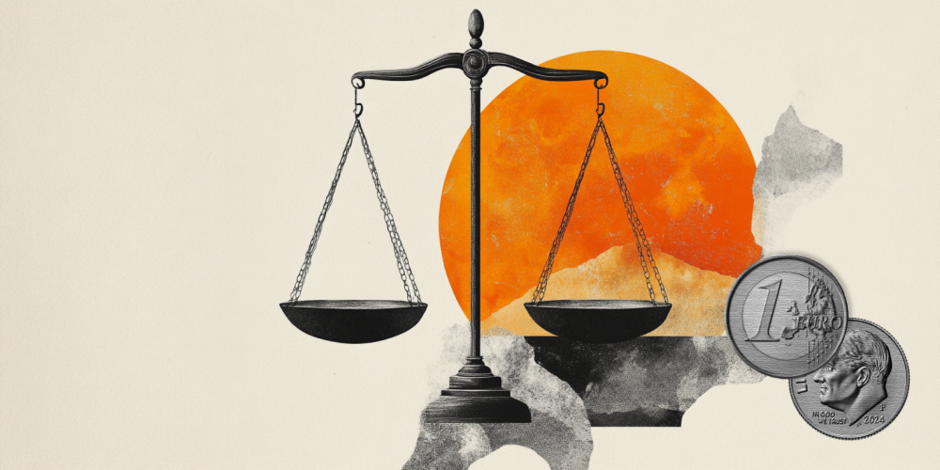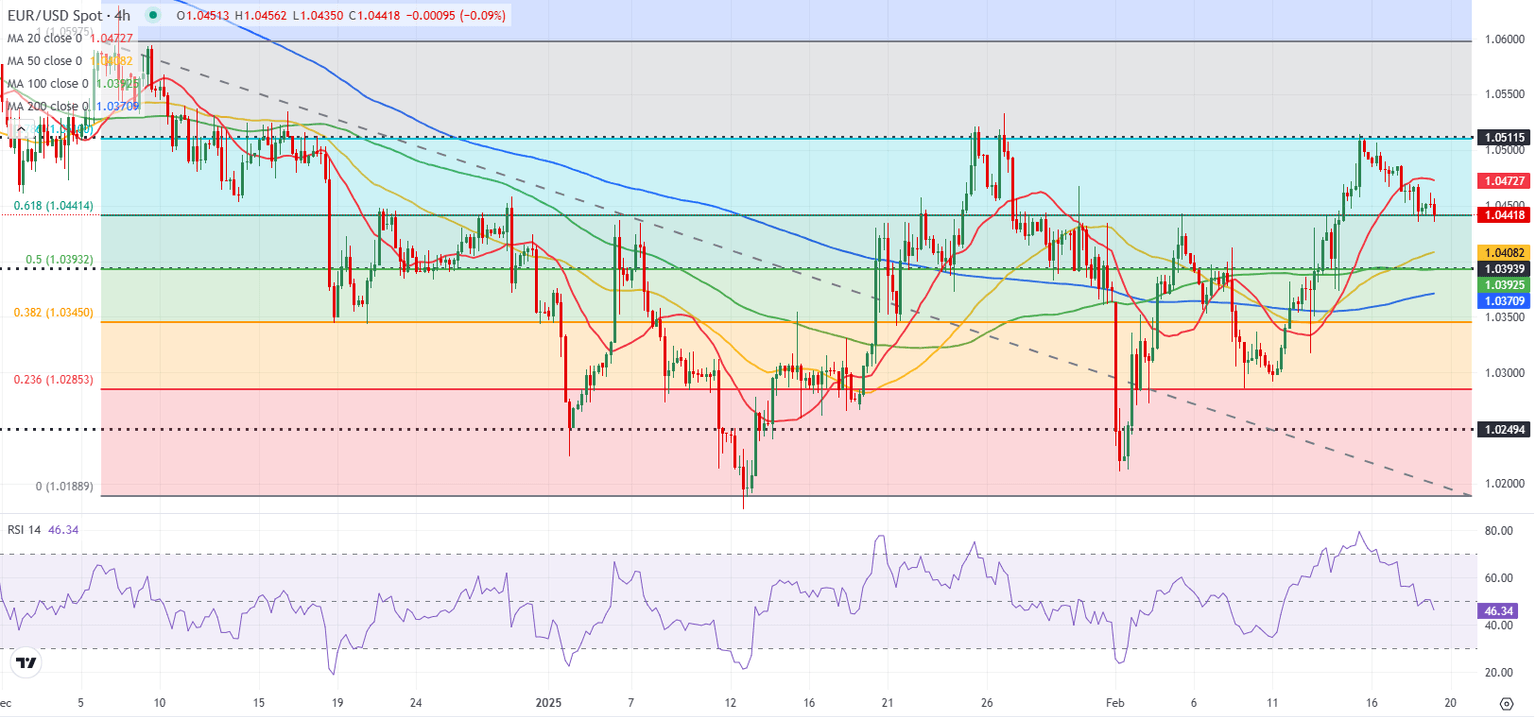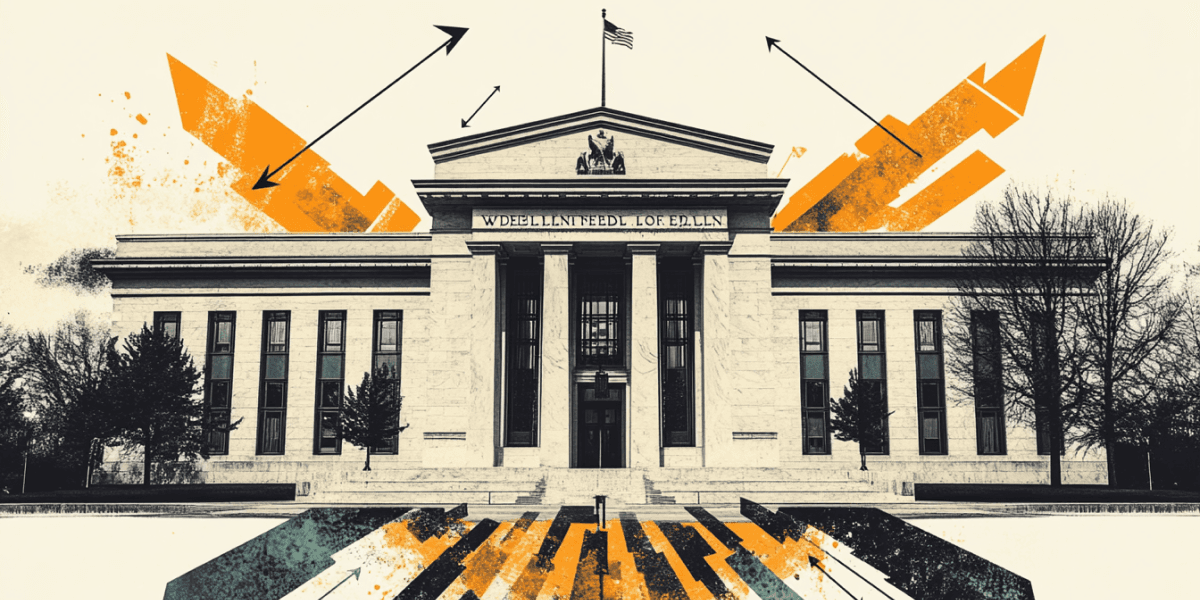EUR/USD Forecast: Euro stays fragile ahead of FOMC Minutes
- EUR/USD struggles to stage a rebound following Tuesday's decline.
- The technical outlook points to a bearish shift in the near-term bias.
- The Federal Reserve will release the minutes of the January policy meeting later in the day.

EUR/USD stays on the back foot and trades below 1.0450 after closing in the negative territory on Tuesday. The pair's short-term technical outlook highlights a bearish tilt.
Euro PRICE This week
The table below shows the percentage change of Euro (EUR) against listed major currencies this week. Euro was the weakest against the Japanese Yen.
| USD | EUR | GBP | JPY | CAD | AUD | NZD | CHF | |
|---|---|---|---|---|---|---|---|---|
| USD | 0.48% | -0.25% | -0.36% | 0.08% | -0.18% | -0.16% | 0.56% | |
| EUR | -0.48% | -0.57% | -0.87% | -0.30% | -0.57% | -0.54% | 0.18% | |
| GBP | 0.25% | 0.57% | -0.19% | 0.27% | 0.05% | 0.03% | 0.75% | |
| JPY | 0.36% | 0.87% | 0.19% | 0.44% | 0.22% | 0.42% | 0.89% | |
| CAD | -0.08% | 0.30% | -0.27% | -0.44% | -0.23% | -0.24% | 0.48% | |
| AUD | 0.18% | 0.57% | -0.05% | -0.22% | 0.23% | 0.03% | 0.74% | |
| NZD | 0.16% | 0.54% | -0.03% | -0.42% | 0.24% | -0.03% | 0.72% | |
| CHF | -0.56% | -0.18% | -0.75% | -0.89% | -0.48% | -0.74% | -0.72% |
The heat map shows percentage changes of major currencies against each other. The base currency is picked from the left column, while the quote currency is picked from the top row. For example, if you pick the Euro from the left column and move along the horizontal line to the US Dollar, the percentage change displayed in the box will represent EUR (base)/USD (quote).
EUR/USD came under modest bearish pressure in the American session on Tuesday as markets adopted a cautious stance. US President Donald Trump said late Tuesday that they are looking to impose tariffs on car imports "in the neighborhood of 25%" as early as April 2. He also noted that they are also planning to charge similar duties on pharmaceutical and semiconductor imports.
Meanwhile, European Central Bank (ECB) policymaker Fabio Panetta said early Wednesday that the signs of weakness in the Eurozone economy seem to be more persistent than anticipated, making it difficult for the Euro to stay resilient against its rivals.
Later in the American session, the Federal Reserve will publish the minutes of the January policy meeting. According to the CME FedWatch Tool, markets see virtually no chance of a rate cut in March. This publication is unlikely to influence the market pricing of the Fed rate outlook in a significant way. Hence, the risk perception could continue to drive the US Dollar's valuation and impact EUR/USD's action. At the time of press, US stock index futures were trading marginally higher on the day. A bullish action in Wall Street after the opening bell could help EUR/USD hold its ground.
EUR/USD Technical Analysis
The Relative Strength Index (RSI) indicator on the 4-hour chart declined below 50, reflecting a bearish tilt in the short-term outlook.
On the downside, 1.0440 (Fibonacci 61.8% retracement level of the latest downtrend) aligns as a key pivot level. In case EUR/USD confirms this level as resistance, 1.0400 (100-period SMA, Fibonacci 50% retracement), 1.0370 (200-period SMA) and 1.0350 (Fibonacci 38.2% retracement) could be seen as next support levels.
Looking north, resistances could be spotted at 1.0500-1.0510 (round level, Fibonacci 78.6% retracement), 1.0550 (static level) and 1.0600 (static level, beginning point of the downtrend).
Euro FAQs
The Euro is the currency for the 19 European Union countries that belong to the Eurozone. It is the second most heavily traded currency in the world behind the US Dollar. In 2022, it accounted for 31% of all foreign exchange transactions, with an average daily turnover of over $2.2 trillion a day. EUR/USD is the most heavily traded currency pair in the world, accounting for an estimated 30% off all transactions, followed by EUR/JPY (4%), EUR/GBP (3%) and EUR/AUD (2%).
The European Central Bank (ECB) in Frankfurt, Germany, is the reserve bank for the Eurozone. The ECB sets interest rates and manages monetary policy. The ECB’s primary mandate is to maintain price stability, which means either controlling inflation or stimulating growth. Its primary tool is the raising or lowering of interest rates. Relatively high interest rates – or the expectation of higher rates – will usually benefit the Euro and vice versa. The ECB Governing Council makes monetary policy decisions at meetings held eight times a year. Decisions are made by heads of the Eurozone national banks and six permanent members, including the President of the ECB, Christine Lagarde.
Eurozone inflation data, measured by the Harmonized Index of Consumer Prices (HICP), is an important econometric for the Euro. If inflation rises more than expected, especially if above the ECB’s 2% target, it obliges the ECB to raise interest rates to bring it back under control. Relatively high interest rates compared to its counterparts will usually benefit the Euro, as it makes the region more attractive as a place for global investors to park their money.
Data releases gauge the health of the economy and can impact on the Euro. Indicators such as GDP, Manufacturing and Services PMIs, employment, and consumer sentiment surveys can all influence the direction of the single currency. A strong economy is good for the Euro. Not only does it attract more foreign investment but it may encourage the ECB to put up interest rates, which will directly strengthen the Euro. Otherwise, if economic data is weak, the Euro is likely to fall. Economic data for the four largest economies in the euro area (Germany, France, Italy and Spain) are especially significant, as they account for 75% of the Eurozone’s economy.
Another significant data release for the Euro is the Trade Balance. This indicator measures the difference between what a country earns from its exports and what it spends on imports over a given period. If a country produces highly sought after exports then its currency will gain in value purely from the extra demand created from foreign buyers seeking to purchase these goods. Therefore, a positive net Trade Balance strengthens a currency and vice versa for a negative balance.
US Dollar FAQs
The US Dollar (USD) is the official currency of the United States of America, and the ‘de facto’ currency of a significant number of other countries where it is found in circulation alongside local notes. It is the most heavily traded currency in the world, accounting for over 88% of all global foreign exchange turnover, or an average of $6.6 trillion in transactions per day, according to data from 2022. Following the second world war, the USD took over from the British Pound as the world’s reserve currency. For most of its history, the US Dollar was backed by Gold, until the Bretton Woods Agreement in 1971 when the Gold Standard went away.
The most important single factor impacting on the value of the US Dollar is monetary policy, which is shaped by the Federal Reserve (Fed). The Fed has two mandates: to achieve price stability (control inflation) and foster full employment. Its primary tool to achieve these two goals is by adjusting interest rates. When prices are rising too quickly and inflation is above the Fed’s 2% target, the Fed will raise rates, which helps the USD value. When inflation falls below 2% or the Unemployment Rate is too high, the Fed may lower interest rates, which weighs on the Greenback.
In extreme situations, the Federal Reserve can also print more Dollars and enact quantitative easing (QE). QE is the process by which the Fed substantially increases the flow of credit in a stuck financial system. It is a non-standard policy measure used when credit has dried up because banks will not lend to each other (out of the fear of counterparty default). It is a last resort when simply lowering interest rates is unlikely to achieve the necessary result. It was the Fed’s weapon of choice to combat the credit crunch that occurred during the Great Financial Crisis in 2008. It involves the Fed printing more Dollars and using them to buy US government bonds predominantly from financial institutions. QE usually leads to a weaker US Dollar.
Quantitative tightening (QT) is the reverse process whereby the Federal Reserve stops buying bonds from financial institutions and does not reinvest the principal from the bonds it holds maturing in new purchases. It is usually positive for the US Dollar.
Premium
You have reached your limit of 3 free articles for this month.
Start your subscription and get access to all our original articles.
Author

Eren Sengezer
FXStreet
As an economist at heart, Eren Sengezer specializes in the assessment of the short-term and long-term impacts of macroeconomic data, central bank policies and political developments on financial assets.

















